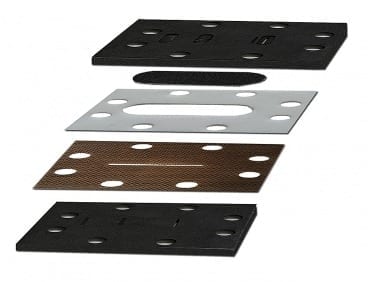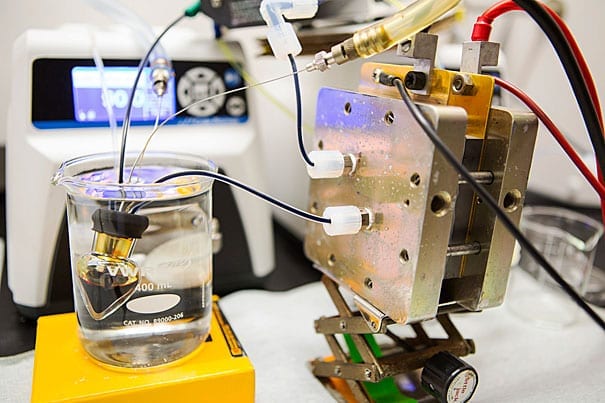
Design may support widespread use of solar and wind energy.
MIT researchers have engineered a new rechargeable flow battery that doesn’t rely on expensive membranes to generate and store electricity. The device, they say, may one day enable cheaper, large-scale energy storage.
The palm-sized prototype generates three times as much power per square centimeter as other membraneless systems — a power density that is an order of magnitude higher than that of many lithium-ion batteries and other commercial and experimental energy-storage systems.
The device stores and releases energy in a device that relies on a phenomenon called laminar flow: Two liquids are pumped through a channel, undergoing electrochemical reactions between two electrodes to store or release energy. Under the right conditions, the solutions stream through in parallel, with very little mixing. The flow naturally separates the liquids, without requiring a costly membrane.
The reactants in the battery consist of a liquid bromine solution and hydrogen fuel. The group chose to work with bromine because the chemical is relatively inexpensive and available in large quantities, with more than 243,000 tons produced each year in the United States.
In addition to bromine’s low cost and abundance, the chemical reaction between hydrogen and bromine holds great potential for energy storage. But fuel-cell designs based on hydrogen and bromine have largely had mixed results: Hydrobromic acid tends to eat away at a battery’s membrane, effectively slowing the energy-storing reaction and reducing the battery’s lifetime.
To circumvent these issues, the team landed on a simple solution: Take out the membrane.
“This technology has as much promise as anything else being explored for storage, if not more,” says Cullen Buie, an assistant professor of mechanical engineering at MIT. “Contrary to previous opinions that membraneless systems are purely academic, this system could potentially have a large practical impact.”
Buie, along with Martin Bazant, a professor of chemical engineering, and William Braff, a graduate student in mechanical engineering, have published their results this week inNature Communications.
“Here, we have a system where performance is just as good as previous systems, and now we don’t have to worry about issues of the membrane,” Bazant says. “This is something that can be a quantum leap in energy-storage technology.”
Possible boost for solar and wind energy
Low-cost energy storage has the potential to foster widespread use of renewable energy, such as solar and wind power. To date, such energy sources have been unreliable: Winds can be capricious, and cloudless days are never guaranteed. With cheap energy-storage technologies, renewable energy might be stored and then distributed via the electric grid at times of peak power demand.
“Energy storage is the key enabling technology for renewables,” Buie says. “Until you can make [energy storage] reliable and affordable, it doesn’t matter how cheap and efficient you can make wind and solar, because our grid can’t handle the intermittency of those renewable technologies.”
By designing a flow battery without a membrane, Buie says the group was able to remove two large barriers to energy storage: cost and performance. Membranes are often the most costly component of a battery, and the most unreliable, as they can corrode with repeated exposure to certain reactants.
Braff built a prototype of a flow battery with a small channel between two electrodes. Through the channel, the group pumped liquid bromine over a graphite cathode and hydrobromic acid under a porous anode. At the same time, the researchers flowed hydrogen gas across the anode. The resulting reactions between hydrogen and bromine produced energy in the form of free electrons that can be discharged or released.
The researchers were also able to reverse the chemical reaction within the channel to capture electrons and store energy — a first for any membraneless design.
In experiments, Braff and his colleagues operated the flow battery at room temperature over a range of flow rates and reactant concentrations. They found that the battery produced a maximum power density of 0.795 watts of stored energy per square centimeter.
The Latest Bing News on:
Flow battery
- Nigeria: Battery storage system from US to energy companyon May 8, 2024 at 12:31 am
A Nigerian energy company is to be the recipient of the largest US government-financed battery storage system exported to Africa.
- A Technology Liftoff for CMBlu Flow Batteries that could Lower Microgrid Costs with Easily Sourced Componentson May 6, 2024 at 7:31 am
Flow batteries are beginning to appear in microgrids, providing cost savings, long-duration storage and a U.S. supply chain. Two national laboratories are studying how CMBlu ...
- A Company Is Building a Giant Compressed-Air Battery in the Australian Outbackon May 4, 2024 at 4:00 am
Hydrostor, a leader in compressed air energy storage, aims to break ground on its first large-scale plant in New South Wales by the end of this year. It wants to follow that with an even bigger ...
- Researchers repurpose commonplace chemical with incredible properties in new battery design: 'Exhibited remarkable cycling stability'on May 2, 2024 at 4:15 am
Scientists have created a new type of battery for grid energy storage by repurposing a chemical commonly used in water treatment plants. They say it has huge potential to increase grid resiliency.
- Tribal company and Oregon battery startup create unique partnership in pursuit of clean energyon April 29, 2024 at 2:03 pm
Madisen McCleary, Skip Tech's vice president of engineering, makes a hydrophobic coating for the interior of a flow cell for the startup's hydrogen ...
- New All-Liquid Iron Flow Battery for Grid Energy Storageon March 27, 2024 at 5:01 pm
The design provides a pathway to a safe, economical, water-based, flow battery made with Earth-abundant materials. It provides another pathway in the quest to incorporate intermittent energy sources ...
- Scientists reveal new flow battery tech based on common chemicalon March 25, 2024 at 11:38 am
At the center of the design is a lab-scale, iron-based flow battery with unparalleled cycling stability. According to a statement, the battery “exhibited remarkable cycling stability over one thousand ...
- Best Solar Batteries of May 2024on March 25, 2024 at 10:42 am
Instead, NiCad storage packs work well for small devices such as solar garden lights. Flow batteries, also known as redox (reduction-oxidation) batteries, are an emerging technology for large ...
- flow batteryon March 8, 2024 at 4:00 pm
Vanadium flow batteries are an interesting project, with the materials easily obtainable by the DIY hacker. To that effect [Cayrex2] over on YouTube presents their take on a small, self-contained ...
- Everything you need to know about the types of solar batterieson February 20, 2024 at 12:10 pm
Four types of solar batteries are common in residential applications: lithium ion, lead acid, nickel cadmium and flow solar batteries. Each type serves the same purpose but uses different ...
The Latest Google Headlines on:
Flow battery
[google_news title=”” keyword=”Flow battery” num_posts=”10″ blurb_length=”0″ show_thumb=”left”]
The Latest Bing News on:
Cheap energy-storage technologies
- Sea-bed 'air batteries' offer cheaper long-term energy storageon May 6, 2024 at 1:21 am
Israeli company BaroMar is preparing to test a clever new angle on grid-level energy storage, which it says will be the cheapest way to stabilize renewable grids over longer time scales. This ...
- Scientists design super-battery made with cheap, readily affordable chemical element, Na — Salt-based cell has surprisingly good energy density and charges in secondson April 29, 2024 at 9:50 pm
Researchers at the Korea Advanced Institute of Science and Technology (KAIST) have developed a high-performance, hybrid sodium-ion battery that charges rapidly and offers impressive energy ...
- Battery energy storage developments that are electrifying the sectoron April 25, 2024 at 6:59 am
Battery energy storage is vital for a clean energy future. Kit Million Ross explores new developments in the sector.
- MIT Technology Reviewon April 14, 2024 at 5:00 pm
Thermal energy storage could connect cheap but intermittent renewable electricity ... Rondo is working to show that its technology can integrate into a sector where cost is key.
- 90-GWh thermal energy storage facility could heat a city for a yearon April 9, 2024 at 3:14 am
An energy supplier in Finland has announced the upcoming construction of an underground seasonal thermal energy storage facility ... power have become vital technologies in the transition from ...
- Salt, air and bricks: could this be the future of energy storage?on April 1, 2024 at 5:35 am
“Driving forward energy storage technologies will be vital in our transition towards cheap, clean and secure renewable energy,” he said. A 2022 report from the consultancy firm McKinsey ...
- Salt, air and bricks: could this be the future of energy storage?on April 1, 2024 at 12:00 am
Start-ups turn to heat over batteries and are aiming to industrialise the practice ...
- Liquid Tin Could Be The Key To Cheap, Plentiful Grid Storageon January 7, 2024 at 11:09 pm
Fourth Power is making waves with its “sun in a box” energy storage technology ... with graphite and tin being abundant and cheap compared to the fancy materials required to fabricate high ...
- Weird Energy Storage Solutions Could Help The Grid Go Renewableon November 29, 2022 at 2:19 am
However, new technologies for storing energy are on the horizon for grid storage purposes ... The chemicals involved are also cheap and readily available – iron and its salts being easy to ...
- Want The Cheapest Electricity? Build Solar And Wind Farms, Not Coal Power Plantson November 21, 2018 at 7:00 am
Onshore wind power and solar – without subsidies – are now the cheapest source of new ... of different power generating and energy storage technologies globally, excluding subsidies.
The Latest Google Headlines on:
Cheap energy-storage technologies
[google_news title=”” keyword=”cheap energy-storage technologies” num_posts=”10″ blurb_length=”0″ show_thumb=”left”]










